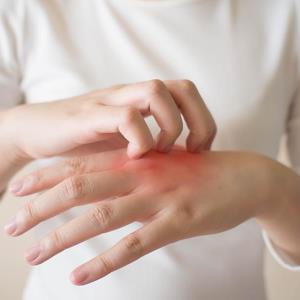Treatment with dupilumab substantially improves symptoms, quality of life, and other outcomes in patients with atopic hand and foot dermatitis (H/F AD), with an acceptable safety profile, results of a study have shown.
“This study supports dupilumab as a novel efficacious systemic therapy for moderate-to-severe H/F AD,” said the investigators, led by Eric L Simpson, MD, Department of Dermatology, Oregon Health & Science University, Portland, Oregon, US.
Simpson and his team conducted this multicentre phase III trial involving adults and adolesecents with moderate-to-severe HF/AD. They randomized 133 participants (adults: n=106; adolescents: n=27) to receive either dupilumab monotherapy (n=67; regimen approved for generalized AD) or matched placebo (n=66). [J Am Acad Dermatol 2024;90:1190-1199]
The proportion of patients achieving Hand and Food Investigator’s Global Assessment (HF-IGA) score 0 or 1 at week 16 served as the primary outcome. Other endpoints assessed included the severity and extent of signs, symptom intensity (eg, itch, pain), quality of life, and sleep.
At week 16, more dupilumab-treated patients (n=27) than placebo-treated individuals (n=11) achieved HF-IGA 0/1 (40.3 percent vs 16.7 percent; p=0.003). Similarly, more patients in the dupilumab arm than those in the placebo arm achieved the secondary endpoint of ≥4-point reduction in HF-Peak Pruritus Numeric Rating Scale (NRS) score from baseline (52.2 percent vs 13.6 percent; p<0.0001).
Dupilumab monotherapy, compared with placebo, also significantly improved skin lesions (percent change in HF-modified Total Lesion Sign Score: ‒69.4 percent vs ‒31.0 percent; p<0.0001; Hand Eczema Severity Index: ‒74.8 percent vs‒39.9 percent; p<0.0001) at week 16. Additionally, patients treated with dupilumab achieved significant change in HF-Peak Pain NRS (‒4.7 percent vs ‒1.9 percent; p<0.0001).
In terms of safety, treatment-emergent adverse events (TEAEs) were slightly fewer in the dupilumab arm (65.7 percent vs 74.2 percent). More placebo-treated patients also discontinued treatment due to TEAEs (1.5 percent vs 4.5 percent). Serious AEs occurred in two patients who received dupilumab and in one who received placebo (3.0 percent vs 1.5 percent), but none of which were deemed treatment-related.
“The safety profile of dupilumab was similar to that in adults and adolescents with generalized moderate-to-severe AD, for which dupilumab is licensed,” Simpson said. [N Engl J Med 2016;375:2335-2348; JAMA Dermatol 2020;156:44-56; J Dermatol Sci 2019;94:266-275]
JAK inhibitors
Other treatments being considered for chronic hand eczema are Janus kinase inhibitors (JAKis). Topical JAKis such as delgocitinib and oral JAKis like upadacitinib and abrocitinib are all undergoing phase II and III trials, respectively. However, no efficacy data are available for foot dermatitis or H/F AD. [Br J Dermatol 2020;182:1103-1110; J Eur Acad Dermatol Venereol 2023;37:1863-1870]
“Unlike dupilumab, which is a targeted immunomodulator, JAKis are considered broad immunosuppresants,” Simpson said.
However, use of JAKis is believed to contribute to a higher risk of infections and requires constant monitoring for hyperlipidaemia and cytopoenias, according to the investigators.
“Nevertheless, these studies, including the study reported herein, identify potential systemic options for a highly burdensome disease subtype that greatly impacts patients,” Simpson said.
The current study was limited by its relatively short 16-week treatment duration. “Given the high number of patients who had positive patch tests in the study population, the possibility that some enrolled patients had overlapping allergic contact dermatitis alongside AD cannot be ruled out, and further evaluation is needed to investigate the effect of dupilumab in these patients,” Simpson said.

